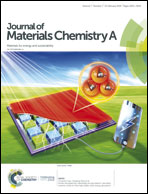In situ extracted poly(acrylic acid) contributing to electrospun nanofiber separators with precisely tuned pore structures for ultra-stable lithium–sulfur batteries†
Abstract
Lithium–sulfur (Li–S) batteries are extremely attractive for next-generation energy storage technologies owing to their high energy density, low cost and environmental friendliness. Nevertheless, the severe shuttle effect of soluble lithium polysulfides (LiPS) has been one of the major technical challenges causing the rapid capacity fading of Li–S batteries. Herein, we prepare a uniquely designed polyacrylonitrile/poly(acrylic acid) composite nanofiber separator with controllable pore structures and abundant electronegative groups, which is denoted as E-PAN/PAA, to effectively suppress the shuttling effect of LiPS. By a facile electrospinning strategy combined with ethanol steaming treatment, poly(acrylic acid) can be in situ extracted out from the inside of PAN/PAA composite nanofibers to precisely tune the pore structure of the nanofiber separator. As a result, the optimized E-PAN/PAA separator can act as an ionic sieve to allow fast Li+ transport while effectively inhibiting LiPS migration as well, leading to a high initial capacity of 1232 mA h g−1 at 0.1C and a remarkable cycling stability with an ultra-low fading rate of 0.03% per cycle over 500 cycles at 1C. Moreover, the E-PAN/PAA separator presents a remarkable combination of excellent electrolyte wettability, thermal stability and mechanical properties, providing a valuable strategy for the design and manufacture of advanced Li–S battery separators.



 Please wait while we load your content...
Please wait while we load your content...